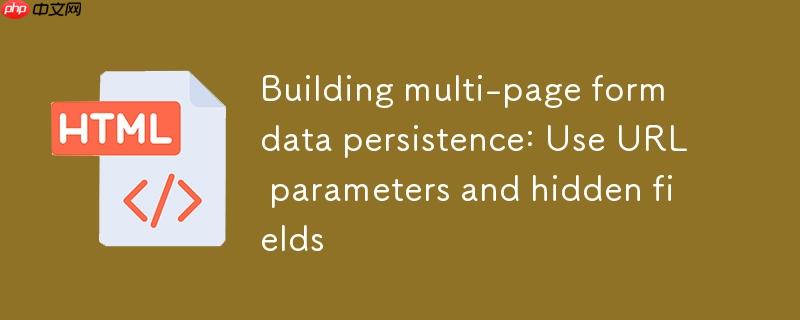
在现代Web应用中,多步骤表单(或向导式表单)是常见的交互模式,用于收集复杂或分阶段的用户信息。然而,在页面之间跳转时,如何有效地传递和持久化用户输入的数据,是一个常见的挑战。本文将深入探讨这一问题,并提供一种健壮的解决方案,确保数据在整个多页流程中不丢失。
当我们构建一个多页表单时,通常会使用JavaScript来处理表单提交,并通过修改window.location.href来导航到下一个页面,同时将当前页面的数据作为URL查询参数传递。例如,从页面A跳转到页面B时,URL可能形如 pageB.html?param1=value1¶m2=value2。
问题通常出现在后续页面。当页面B加载并包含自己的表单时,如果页面B的JavaScript尝试使用new FormData(event.target)来收集数据,它只会捕获当前页面表单中存在的字段。这意味着,如果页面B的HTML中没有包含来自页面A的字段(例如email或testType),那么这些数据将不会被FormData对象捕获,从而在提交到页面C时丢失。
示例代码分析:
考虑以下场景:
原始的goPThree函数(假设在页面2中触发)将email和testType成功传递到页面3:
function goPThree(event) {
event.preventDefault();
const formData = new FormData(event.target);
const userEmail = formData.get("email"); // 从页面2表单获取
const testType = formData.get("testType"); // 从页面2表单获取
if (testType === "voip") {
window.location.href = "evalportalv3.html?" + "email=" + userEmail + "&testType=" + testType;
} else if (testType === "bandwidth") {
window.location.href = "evalportalb3.html?" + "email=" + userEmail + "&testType=" + testType;
} else {
alert("Please pick a valid Option");
}
return false;
}当页面3加载时,URL中包含了email和testType。然而,页面3的HTML(如下所示)只包含 testTime 的输入字段,而没有email或testType的字段:
<!-- 页面3 (evalportalv3.html) 的简化结构 -->
<form id="myForm" onsubmit="goPFour(event)" method="get">
<div>
<label for="testTime">How long would you like the VoIP test to run?</label>
<input type="radio" class="testD" name="testTime" value="10" checked/>10 Seconds
<input type="radio" class="testD" name="testTime" value="20" />20 Seconds
</div>
<input type="submit" id="subButton" value="Next..." />
</form>此时,当页面3的goPFour函数被调用时:
function goPFour(event) {
event.preventDefault();
const formData = new FormData(event.target);
const userEmail = formData.get("email"); // 尝试从当前表单获取,但字段不存在
const testType = formData.get("testType"); // 尝试从当前表单获取,但字段不存在
const testTime = formData.get("testTime"); // 成功获取
// ... 构造URL并跳转到页面4
}formData.get("email")和formData.get("testType")将返回null,因为当前页面表单中没有名为email或testType的输入元素。这导致这些数据在跳转到页面4时丢失。
为了解决这个问题,我们需要确保在每个中间页面,从前一页接收到的数据能够被当前页面的表单“重新捕获”或“重新包含”。最有效的方法是结合使用URL参数和隐藏输入字段:
步骤1:修改页面3 ( evalportalv3.html ) 的HTML
在页面3的表单中添加隐藏字段,用于存储从页面2接收到的email和testType。
<html lang="en">
<head>
<meta charset="UTF-8">
<title>VoIP/Bandwidth Test Duration</title>
</head>
<body>
<form id="myForm" onsubmit="goPFour(event)" method="get">
<!-- 隐藏字段,用于持久化来自前一页的数据 -->
<input type="hidden" id="emailHidden" name="email" value="" />
<input type="hidden" id="testTypeHidden" name="testType" value="" />
<div id="pBFContainer" class="container">
<div id="bodyFOption1">
<label for="testTime">How long would you like the VoIP test to run?</label>
<input type="radio" class="testD" name="testTime" value="10" checked/>10 Seconds
<input type="radio" class="testD" name="testTime" value="20" />20 Seconds
</div>
</div>
<input type="submit" id="subButton" value="Next..." />
</form>
<script type="text/javascript" src="evalportalp1.js"></script>
<!-- 页面特有的脚本,用于处理URL参数 -->
<script type="text/javascript">
document.addEventListener('DOMContentLoaded', () => {
const urlParams = new URLSearchParams(window.location.search);
const email = urlParams.get('email');
const testType = urlParams.get('testType');
if (email) {
document.getElementById('emailHidden').value = email;
}
if (testType) {
document.getElementById('testTypeHidden').value = testType;
}
});
</script>
</body>
</html>步骤2:修改JavaScript函数 goPFour
现在,goPFour函数将能够从表单中正确获取email和testType(因为它们现在作为隐藏字段存在于表单中),以及当前页面收集的testTime。然后,它将所有这些数据组合起来传递给下一个页面。
// 假设此脚本 (evalportalp1.js) 包含 goPFour 和 goPThree
function goPFour(event) {
event.preventDefault();
const formData = new FormData(event.target);
// 现在可以正确获取所有参数,包括来自隐藏字段的
const userEmail = formData.get("email");
const testType = formData.get("testType");
const testTime = formData.get("testTime");
if (testTime === "10" || testTime === "20") {
// 构建包含所有累积参数的查询字符串
let queryString = `email=${encodeURIComponent(userEmail)}&testType=${encodeURIComponent(testType)}&testTime=${encodeURIComponent(testTime)}`;
window.location.href = `evalportalv4.html?${queryString}`;
} else {
alert("Please pick a valid Option");
}
return false;
}
// goPThree 函数保持不变,它负责将数据从页面2传递到页面3
function goPThree(event) {
event.preventDefault();
const formData = new FormData(event.target);
const userEmail = formData.get("email");
const testType = formData.get("testType");
if (testType === "voip") {
window.location.href = "evalportalv3.html?" + "email=" + encodeURIComponent(userEmail) + "&testType=" + encodeURIComponent(testType);
} else if (testType === "bandwidth") {
window.location.href = "evalportalb3.html?" + "email=" + encodeURIComponent(userEmail) + "&testType=" + encodeURIComponent(testType);
} else {
alert("Please pick a valid Option");
}
return false;
}注意事项:
在构建多页表单时,数据持久化是关键。通过巧妙地结合使用URL参数和隐藏输入字段,我们可以确保用户在不同页面之间跳转时,之前输入的数据能够被有效传递和累积。理解FormData对象的工作原理以及如何利用HTML和JavaScript的特性来“重新捕获”数据,是实现这一目标的核心。采用本文介绍的方法,可以构建出功能强大、用户体验良好的多步骤Web表单。
以上就是构建多页表单数据持久化:使用URL参数和隐藏字段的详细内容,更多请关注php中文网其它相关文章!

每个人都需要一台速度更快、更稳定的 PC。随着时间的推移,垃圾文件、旧注册表数据和不必要的后台进程会占用资源并降低性能。幸运的是,许多工具可以让 Windows 保持平稳运行。




Copyright 2014-2025 https://www.php.cn/ All Rights Reserved | php.cn | 湘ICP备2023035733号